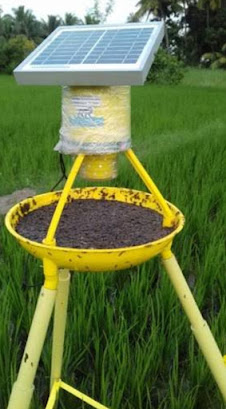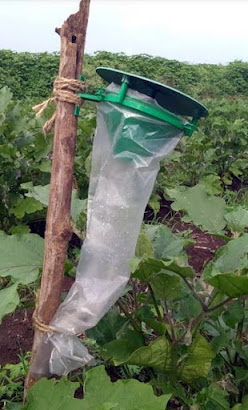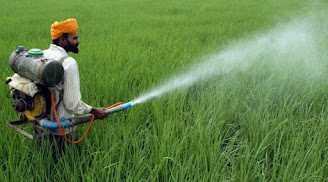Introduction:
A pest is any animal or plant which has a harmful effect on the agricultural plant. Evenly human is also a pest if they harm on agricultural plant and the pesticide is any chemical substance or mixture of substances intended for preventing, destroying, or controlling any pest, including vectors of human or animal disease, unwanted species of plants(weed) or animals(insect and non-insect), causing harm during or otherwise interfering with the production, processing, storage, transport etc.
In general, we can say that pesticide is a chemical substance which used to reduce or kill the pest. The term pesticide includes herbicide (for weeds), Insecticide (for insects), nematicide, molluscicide, piscicide, avicide, rodenticide, bactericide, insect repellent, animal repellent, antimicrobial, and fungicide.
History:
Agricultural crops suffer from pest causing a huge loss in yield. The losses due to pest and disease is 10 - 90% with an average of 35 - 40%. The first record of pesticides use comes from the time of Sumerians (About 4500 years ago) who used sulphur compounds to control insect and mites. In Rigveda it is also mentioned that humans used the poisonous plant to control the pests. In the 15th century, toxic chemicals such as arsenic, mercury and lead were used as pesticides. In 17th century, nicotine sulfate was extracted from tobacco leaves and use as Insecticide.
Some important dates:
1910: The first legislation providing federal authority for regulating.
1940: Began the production of synthetic pesticide in a large amount.
1940-1950: Start of the "pesticide era."
1960: Herbicide became common
1960: Use of DDT
1972: U.S. environment protection agency amendment to the pesticide law to balance the use of pesticide.
Types of pesticide:
The various type of pesticides is: Acaricide, Bactericide, Fungicide, Herbicide, Insecticide
Molluscicide, Nematicide, Rodenticide, Algaecide, Talpicida, Virucide.
Other categories: The European Union has regulated pesticides in the directive on its sustainable use, dividing them into two categories: Phytosanitary products and Biocides
Uses of pesticide:
Pesticides are used to control various pests and disease carriers. There are many different types of pesticides and each pesticide has specific effectiveness against the target pest. Some major pesticides used in agriculture field are:
- Algaecides: to kill or reduce the growth of algae.
- Antimicrobials: to control germs and microbes such as bacteria and viruses.
- Disinfectants: to control germs and microbes such as bacteria and viruses.
- Fungicides: to control fungal problems like moulds, mildew, and rust.
- Herbicides: to kill or inhibit the growth of unwanted plants, also known as weeds.
- Insecticides: to control insects.
- Rodenticides: to kills rodents like mice, rats, and gophers.
Also visite
How to manage the Pest on paddy field
Pesticide: Boon or Bane
Rachel Carson in her famous book "Silent Spring" had adeptly said, “How could intelligent beings seek to control a few unwanted species by a method that contaminated the entire environment and brought the threat of disease and death even to their own kind?”
In the present scenario, use of pesticide has become essential as control of pest is necessary to achieve high amount of crop yield. On the other side, increase in use of pesticides shows increased side effects. Everything has a limit and when we cross that limit then we see the negative side of that thing. In the below section benefits of using pesticide and side effects of using pesticide and how to overcome from this by using alternatives has been discussed.
- Benefits of using pesticide:
Every year pest consumes a large amount of agricultural crop so cultivation without using pesticide causes huge loss in agriculture. The benefit of using pesticide includes an increase in crop yield, prevention of diseases and hence leads to increase in the farmer's profit.
Broadly, there are two types of benefits of using pesticides: primary and secondary. Primary benefits directly impact on our life whereas secondary benefits have a long term impact.
Primary benefits: The harmful organisms that develop in the field at the expense of crops, both directly (insects and cryptogams), and indirectly (weeds) take away from humans, it is estimated, about a quarter of global production. In this estimate, however, other important organisms that impoverish human food sources are not considered, such as warehouse insects, phytophagous mites, nematodes of agricultural interest, molluscs, mammals, rodents. Total loss due to all harmful organisms is around an impressive 35%. An example, referring to rice, the staple food of over three billion people, highlights losses due to the concomitant action of insects, pathogens and weeds, in Asia, it would be around 55% of the total production.
Control of vectors of animal and human diseases and, more generally, of harmful organisms with the consequence of saving human and animal lives or, at least, of less suffering. The fight against diseases is important in many areas of the planet, from which many populations have benefited. The main example is DDT, which has made it possible to eradicate or strongly reduce malaria from some areas of the planet. After the successes in Egypt (1939) and Brazil (1941), the "Sardinian project" started from 1946 to 1951 which radically eliminated malaria from the island. We must not forget the role of the WHO which, over the years, has promoted and carried out extensive campaigns in various areas of the globe for the use of pesticides.
Secondary benefits: Secondary benefits do not directly impact on our life, but it impacts on our life indirectly in long term. In one study it was estimated that if a farmer invests 1 rupee for the use of pesticides than he will return 4 rupees as crop yield. Using pesticides having an increase in crop yield and the farmer being able to produce various type of agricultural production throughout the year. It is also beneficial for the consumer of agricultural product because they can consume a huge amount of agricultural product in affordable price throughout the year.
- Side effects:
Effect on human: According to WHO data, about 10 people die each year from the use of pesticides and 20 are acutely poisoned by their use in agriculture and livestock.
Although for the general population, as a consumer of agricultural products, the risks of suffering consequences on their health due to the use of pesticides. In human health affected by the uses of a pesticide such as irritation of skin and eye, nervous system, and cancer.
One study found that one-third of suicides case is occurring by the eating pesticide. The world health organization and UN environment programme estimate that every year 3 million people in agriculture in the developing world experience severe suffering from the poison of pesticides.
Effect on the environment: Day by day increased use of pesticide is increasing the problem of the environment. Over 98% of sprayed Insecticides and 95% sprayed herbicide reached their target species as well as non-target species such as water, air, soil etc. The pesticide is one of the reasons for water pollution and it also contributes soil and flower contamination. The pesticide also contributes to biodiversity, reduce habitat and threatens endangered species. If we want to reduce the pesticide's effect on the environment than we need to manufacture quickly degradable pesticide or quickly deactivated pesticide on the environment.
Alternative Approach:
Due to various adverse effect of pesticide on human and environment, we need an alternative to the pesticide. Some alternative methods are listed below:
Physical method: Physical factors such as temperature, light, moisture, air etc. are used in modified ways to prevent or reduce the pest problem.
Manipulation of temperature:
Seed drying in the sun to kill the egg or hidden stages of stored products pest.
Hot water treatment of paddy seeds at 50° - 55° centigrade for 15 minutes to control rice white tip nematode.
Use burning torch against hairy caterpillar.
Use flame thrower against locusts.
Manipulation of moisture:
Seeds drying below 10% moisture affect insect development.
Flooding the field to control cutworms.
Manipulation of air:
Increasing the carbon dioxide concentration in controlled atmosphere of stored grains to cause asphyxiation in stored product pests.
Manipulation of light:
Use of light traps to attract positively phototropic insects.
Treating of storage grains with IR light to kill all stages of insects.
Use of greasing material:
Treating the stored grains particularly pulsea with vegetable oils prevents the oviposition and egg hatching.
Mechanical method: Mechanical methods such as light traps, pheromone traps, yellow sticky traps are used.
Light traps:
 |
| Light traps |
Mostly adult insects are attracted by light in the night. In light traps this principle is used to attract and trap the insect. There are 3 type of light traps incandescent light traps, mercury vapor lamp light traps, black light traps. The mercury vapor lamp light traps are currently used widely to trap the nocturnal flying insects. This light trap model was designed by Robinson in 1952.
Pheromone traps:
 |
| Sex Pheromone traps |
Generally Pheromone is used by the insect for communication to each other but in pheromone traps synthetic sex pheromones are used to attract males. The rubberised septa, containing the pheromone lure are kept in traps designed especially for this purpose and used in insect monitoring and mass trapping programmes. Sticky traps, waterpan traps and funnel type model are available for use in pheromone-based insect control programmes.
Yellow sticky traps: Cotton whitefly, aphids and thrips prefer yellow colour. Yellow colour is painted on tin boxes and sticky material like castor oil or vaseline is smeared on the surface. These insects are attracted to yellow colour and trapped on the sticky material.
Cultural method: Cultural control consists of introducing such minor changes in the ordinary farm practices t co.ontrol the pest population. Farm practices such as summer ploughing, puddling, early sowing, earthing up, intercropping, trap cropping, water management, timely harvest, avoid ratooning etc. are used. Trap cropping like in cotton fields castor use as trap crop on bund to avoid Spodoptera litura. Sorghum intercropped with lablab to minimize sorghum stem borer. Summer ploughing reduce the effect of red hairy caterpillar of groundnut.
Another method is the release of other organisms that fight pests, such as their natural predators and parasites. Biological pesticides are also used, such as plague-pathogenic fungi, bacteria, viruses. It is also possible to alter the biological cycle of the insect by means of sterilization of the males that are later released to mate with females that will not be able to produce young. This technique was used for the first time with the screwworm of cattle in 1958 and has subsequently been used on the Mediterranean fly and the tsetse fly and the Lymantria dispar moth. These procedures can be expensive, time-consuming, and serve only certain species of pests.
Conclusion:
All pesticides have the potential to be harmful to the living organisms and environment.
In modern agriculture use of pesticides is a must but proper and efficient use must be done.
Modern agriculture practices have been great promises to economic development of nation. Farm productivity is directly proportional to use of as observed from the first green revolution.
Poverty and illiteracy are greatly responsible for improper handling of pesticides.
To save present and future generations ecology; judicial use of pesticides is recommended.



0 Comments
Please do not enter any spam link on the comment box